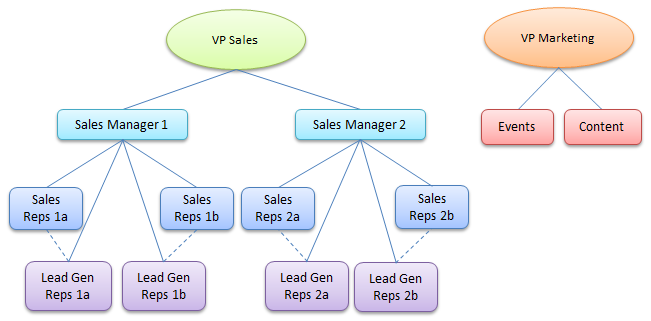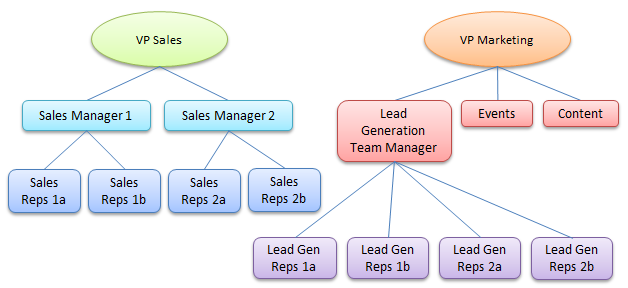A few months ago while attending a Scrum certification course with Jeff Sutherland’s Scrum Inc., I heard something about organizational reporting structures that I found really interesting. Sutherland explained that in his experience working with software development teams, teams with hierarchical reporting structures write hierarchical codes, and the teams that have flat reporting structures write flatter, more modular code. Not being a developer, I’m not exactly sure what the significance of that is in terms of the quality of the software, but what I found interesting is that the product tends to reflect organizational structure.
This made me think about the reporting structure for outbound lead generation teams, as I have now seen and worked with teams organized in a variety of different ways.
Outbound lead generation teams (sometimes referred to as business development or BDR teams) typically either report to marketing or they report to sales, but whether one is more appropriate or productive than the other is often a subject of debate. In the BridgeGroup’s 2012 Lead Generation Metrics Report, 70% of the companies had their outbound lead generation teams reporting up to the sales department. Of the teams with a heavy focus on outbound prospecting, 81% report to the sales department.

BridgeGroup 2012 Lead Generation Metrics and Compensation report. Lead generation teams reporting to marketing or sales.
However, even when the lead generation team reports up to sales there are a variety of different ways that can be organized, and the result can have a significant impact on the team’s culture and success. When executed well, the outbound lead gen team should serve as a bridge between sales and marketing, regardless of which department the team reports up to.
The reason is that your outbound lead gen team has a direct line to prospects at different stages in the buying cycle. They can test competitive messaging and gather key insight into which messages are resonating with prospects and which ones aren’t. The best outbound lead gen teams will work very closely with sales and marketing to continue refining and adjusting the company’s messaging in a coordinated effort rather than isolating that work in a silo. They will also develop close relationships with the sales reps who they’re supporting (especially in more complex sales environments), and in some cases even help move deals along beyond initial qualification.
There are a number of different ways to organize your team, each of which has its own advantages and disadvantages. Ultimately, you should organize your in team in a way that will develop the right culture and relationships with your sales and marketing departments.
Over the course of my next three posts I will dive deeper into three different ways that these teams are commonly organized, and will describe how the way they are organized may influence their alignment, performance, and culture.
Structure 1: Lead generation team manager reports to the VP of sales. Lead generation reps report directly to the lead generation team manager, but have dotted-line reporting to the sales reps who they are supporting.
Lead generation team manager reports to sales
Structure 2: Lead generation representatives report directly up to the sales manager, with dotted-line management to the sales representative who they support. There is no lead generation team manager.
Lead generation reps report to the sales manager
Structure 3: Lead generation team manager reports directly to the VP of marketing. The lead generation representatives report directly to the lead generation team manager.
Lead generation team manager reports to marketing
While it’s commonly debated whether outbound lead generation teams should report to marketing or sales, I would argue that there is actually a lot more to it than that, and that your company’s culture, stage, product, and target market all factor in. Hopefully, this series will give you some ideas for how you should organize your team.
Please weigh in below: Who should outbound lead generation teams report to — marketing or sales?
Sign-up for our Free Weekly Newsletter to get the best new ideas for building technology companies.


